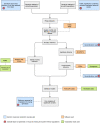Prospective avenues for human population genomics and disease mapping in southern Africa
- PMID: 32440765
- PMCID: PMC7240165
- DOI: 10.1007/s00438-020-01684-8
Prospective avenues for human population genomics and disease mapping in southern Africa
Abstract
Population substructure within human populations is globally evident and a well-known confounding factor in many genetic studies. In contrast, admixture mapping exploits population stratification to detect genotype-phenotype correlations in admixed populations. Southern Africa has untapped potential for disease mapping of ancestry-specific disease risk alleles due to the distinct genetic diversity in its populations compared to other populations worldwide. This diversity contributes to a number of phenotypes, including ancestry-specific disease risk and response to pathogens. Although the 1000 Genomes Project significantly improved our understanding of genetic variation globally, southern African populations are still severely underrepresented in biomedical and human genetic studies due to insufficient large-scale publicly available data. In addition to a lack of genetic data in public repositories, existing software, algorithms and resources used for imputation and phasing of genotypic data (amongst others) are largely ineffective for populations with a complex genetic architecture such as that seen in southern Africa. This review article, therefore, aims to summarise the current limitations of conducting genetic studies on populations with a complex genetic architecture to identify potential areas for further research and development.
Keywords: Admixture mapping; Disease risk alleles; Population genetics; Southern Africa.
Conflict of interest statement
All authors declare no conflict of interest.
Figures

Similar articles
-
Whole-Exome Sequencing Reveals Uncaptured Variation and Distinct Ancestry in the Southern African Population of Botswana.Am J Hum Genet. 2018 May 3;102(5):731-743. doi: 10.1016/j.ajhg.2018.03.010. Epub 2018 Apr 26. Am J Hum Genet. 2018. PMID: 29706352 Free PMC article.
-
The genomic landscape of African populations in health and disease.Hum Mol Genet. 2017 Oct 1;26(R2):R225-R236. doi: 10.1093/hmg/ddx253. Hum Mol Genet. 2017. PMID: 28977439 Free PMC article. Review.
-
Complex patterns of genomic admixture within southern Africa.PLoS Genet. 2013;9(3):e1003309. doi: 10.1371/journal.pgen.1003309. Epub 2013 Mar 14. PLoS Genet. 2013. PMID: 23516368 Free PMC article.
-
Berbers and Arabs: Tracing the genetic diversity and history of Southern Tunisia through genome wide analysis.Am J Phys Anthropol. 2020 Dec;173(4):697-708. doi: 10.1002/ajpa.24139. Epub 2020 Sep 16. Am J Phys Anthropol. 2020. PMID: 32936953
-
Mapping of disease-associated variants in admixed populations.Genome Biol. 2011;12(5):223. doi: 10.1186/gb-2011-12-5-223. Epub 2011 May 30. Genome Biol. 2011. PMID: 21635713 Free PMC article. Review.
Cited by
-
Confirmation of HLA-II associations with TB susceptibility in admixed African samples.Elife. 2025 Jun 3;13:RP99200. doi: 10.7554/eLife.99200. Elife. 2025. PMID: 40458991 Free PMC article.
-
A review of ancestrality and admixture in Latin America and the caribbean focusing on native American and African descendant populations.Front Genet. 2023 Jan 19;14:1091269. doi: 10.3389/fgene.2023.1091269. eCollection 2023. Front Genet. 2023. PMID: 36741309 Free PMC article. Review.
-
Evolutionary Genetics and Admixture in African Populations.Genome Biol Evol. 2023 Apr 6;15(4):evad054. doi: 10.1093/gbe/evad054. Genome Biol Evol. 2023. PMID: 36987563 Free PMC article. Review.
-
Consent Codes: Maintaining Consent in an Ever-expanding Open Science Ecosystem.Neuroinformatics. 2023 Jan;21(1):89-100. doi: 10.1007/s12021-022-09577-4. Epub 2022 Dec 15. Neuroinformatics. 2023. PMID: 36520344 Free PMC article.
-
Challenges of Diagnosing Mendelian Susceptibility to Mycobacterial Diseases in South Africa.Int J Mol Sci. 2023 Jul 28;24(15):12119. doi: 10.3390/ijms241512119. Int J Mol Sci. 2023. PMID: 37569495 Free PMC article. Review.
References
-
- Adeyemo AA, Zaghloul NA, Chen G, Doumatey AP, Leitch CC, Hostelley TL, Nesmith JE, Zhou J, Bentley AR, Shriner D, Fasanmade O, Okafor G, Eghan B, Agyenim-Boateng K, Chandrasekharappa S, Adeleye J, Balogun W, Owusu S, Amoah A, Acheampong J, Johnson T, Oli J, Adebamowo C, Collins F, Dunston G, Rotimi CN. ZRANB3 is an African-specific type 2 diabetes locus associated with beta-cell mass and insulin response. Nat Commun. 2019;10:1–12. - PMC - PubMed
Publication types
MeSH terms
LinkOut - more resources
Full Text Sources

